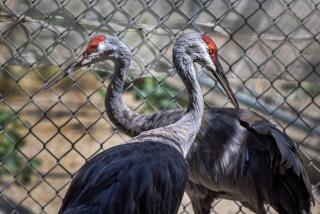Early Socializing by Released Condors Surprises Biologists
- Share via
VENTURA — Wildlife biologist Chris Barr was in the Ventura headquarters of the California Condor Recovery Program when he got the phone call from an excited field biologist: Two groups of condors released 35 miles apart in Los Padres National Forest’s wild back country had just discovered each other and were busy socializing.
Since that first meeting March 31, the two groups have been mixing regularly, roosting together and even sharing a meal on a few occasions.
Birds rubbing beaks, cleaning each other’s feathers and hanging out in a pine tree might not seem like a big deal, but for Barr and other biologists who have been working to save the endangered species from extinction, this was groundbreaking news.
It was the first time that distinct groups of California condors raised in captivity had initiated a meeting in the wild, marking a strong success for a recovery program that has known many setbacks in the past.
Between 1992 and 1994, six condors released in Ventura County died from various brushes with civilization, including ingestion of antifreeze and electrocution from power lines. Those setbacks caused program officials to look for more remote territory in Santa Barbara and San Luis Obispo counties to release the birds.
Last year, 13 condors were released in the Lion Canyon area of the national forest. Just six weeks ago, four more birds were released about 35 miles away--as the condor flies--at Castle Crags in San Luis Obispo County. Biologists expected the two groups to meet eventually but were shocked at how soon the Lion Canyon bunch found their younger counterparts at Castle Crags.
“It’s almost like they have a sixth sense,” said Marguerite Hills, deputy project leader. “These birds are just 2 years old, they had never traveled more than several miles, and yet they just seemed to beeline for these young birds.”
Biologists assume that the condors from Lion Canyon spotted the other birds while they were soaring miles away--they have excellent eyesight--and got curious. As a species, condors are gregarious and prone to socializing.
After a bit of feather preening, the two groups of birds got friendly fast.
“Between one or two of the birds there was some minor aggression initially,” said U.S. Fish & Wildlife spokeswoman Jane Hendron. “But for the most part the birds just immediately began interacting with each other.”
There is a downside to the two groups meeting sooner than the biologists had planned. The birds at Lion Canyon were raised by human beings manipulating hand puppets, but the birds at Castle Crags were raised by condor parents. Biologists had wanted to compare the progress of both separately. But now that the two populations are mixed, that opportunity is gone.
*
On the other hand, the Lion Canyon condors, who are a year older than the Castle Crag birds, can show the younger birds a trick or two.
“One of the advantages of having the two groups meet up is that the Lion Canyon birds are going to be guiding these younger birds out over that whole range of mountains,” Barr said. “They are going to start getting into a lot more back country.”
The older birds actually guided the Castle Crags birds to a major step toward independence: finding their own food.
On Thursday, five of the birds, including two of the youngsters from Castle Crags, found a carcass in the Cuyama Valley, one that the agency had not placed there. Not all five fed on it, but the younger birds had an opportunity to see how they are supposed to find their food.
Although the Lion Canyon birds have been going back and forth between the two sites since March 31, the Castle Crags condors have yet to venture to Lion Canyon. Both sets of birds are still years away from breeding age, which is 6 for condors.
All 17 of the birds are equipped with radio transmitters so that biologists can keep track of their whereabouts. They also have visual markers on their wings.
One of the female condors from Lions Canyon led a field biologist on a merry dance April 4. She soared 85 miles in one day, the longest recorded flight of a condor raised in captivity, and ended up near Parkfield in southern Monterey County before turning back toward home.
“That’s nothing for them,” Hendron said. Condors are capable of going 150 miles in one day. With their nine-foot wing spans, the birds can catch a thermal wind and ride it all day.
Although the condor took a whole day to fly to Parkfield, she only took 90 minutes to return home.
“What that showed us is that these birds really know the way back,” Barr said. “They know what their interests are and they know how to get home. I don’t know if we’ve been giving them enough credit. They know what they are doing.”
More to Read
Sign up for Essential California
The most important California stories and recommendations in your inbox every morning.
You may occasionally receive promotional content from the Los Angeles Times.










